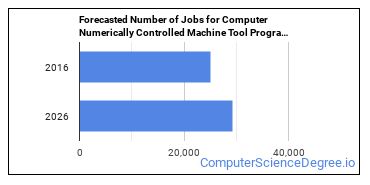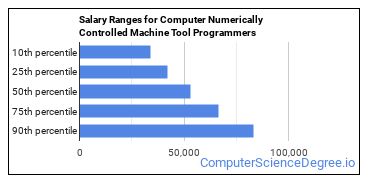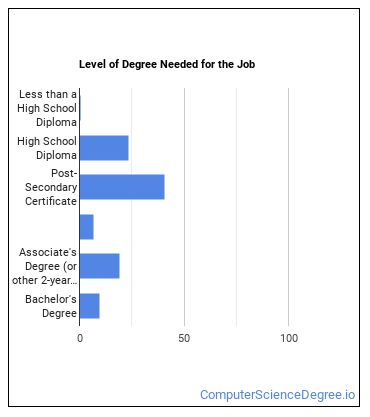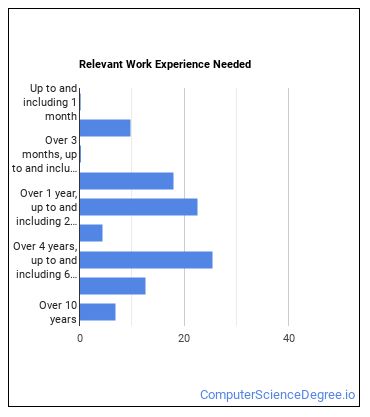What Do Computer Numerically Controlled Machine Tool Programmer Do?
Example of Computer Numerically Controlled Machine Tool Programmer Job Develop programs to control machining or processing of metal or plastic parts by automatic machine tools, equipment, or systems.
Life As a Computer Numerically Controlled Machine Tool Programmer: What Do They Do?
- Observe machines on trial runs or conduct computer simulations to ensure that programs and machinery will function properly and produce items that meet specifications.
- Draw machine tool paths on pattern film, using colored markers and following guidelines for tool speed and efficiency.
- Perform preventative maintenance or minor repairs on machines.
- Revise programs or tapes to eliminate errors, and retest programs to check that problems have been solved.
- Prepare geometric layouts from graphic displays, using computer-assisted drafting software or drafting instruments and graph paper.
- Analyze job orders, drawings, blueprints, specifications, printed circuit board pattern films, and design data to calculate dimensions, tool selection, machine speeds, and feed rates.
Featured schools near , edit
Things a Computer Numerically Controlled Machine Tool Programmer Should Know How to Do
Below is a list of the skills most Computer Numerically Controlled Machine Tool Programmers say are important on the job.
Programming: Writing computer programs for various purposes.
Monitoring: Monitoring/Assessing performance of yourself, other individuals, or organizations to make improvements or take corrective action.
Operation Monitoring: Watching gauges, dials, or other indicators to make sure a machine is working properly.
Reading Comprehension: Understanding written sentences and paragraphs in work related documents.
Mathematics: Using mathematics to solve problems.
Critical Thinking: Using logic and reasoning to identify the strengths and weaknesses of alternative solutions, conclusions or approaches to problems.
Types of Computer Numerically Controlled Machine Tool Programmer Jobs
- Numerical Control Programmer (NC Programmer)
- Computer Numerical Control Machining Center Operator (CNC Machining Center Operator)
- Metal Numerical Control Programmer
- Computer Numerical Control Process Control Programmer (CNC Process Control Programmer)
- Programmer
Is There Job Demand for Computer Numerically Controlled Machine Tool Programmers?
There were about 25,100 jobs for Computer Numerically Controlled Machine Tool Programmer in 2016 (in the United States). New jobs are being produced at a rate of 16.3% which is above the national average. The Bureau of Labor Statistics predicts 4,100 new jobs for Computer Numerically Controlled Machine Tool Programmer by 2026. The BLS estimates 3,100 yearly job openings in this field.

The states with the most job growth for Computer Numerically Controlled Machine Tool Programmer are Utah, Nevada, and South Dakota. Watch out if you plan on working in Washington, Vermont, or Maryland. These states have the worst job growth for this type of profession.
Computer Numerically Controlled Machine Tool Programmer Salary
The typical yearly salary for Computer Numerically Controlled Machine Tool Programmers is somewhere between $33,870 and $83,330.

Computer Numerically Controlled Machine Tool Programmers who work in California, Connecticut, or Massachusetts, make the highest salaries.
Below is a list of the median annual salaries for Computer Numerically Controlled Machine Tool Programmers in different U.S. states.
| State | Annual Mean Salary |
|---|---|
| Alabama | $45,620 |
| Arizona | $59,550 |
| Arkansas | $55,220 |
| California | $66,560 |
| Colorado | $49,040 |
| Connecticut | $65,560 |
| Florida | $53,780 |
| Georgia | $49,990 |
| Idaho | $45,030 |
| Illinois | $54,900 |
| Indiana | $49,490 |
| Iowa | $46,070 |
| Kansas | $59,350 |
| Kentucky | $47,230 |
| Louisiana | $47,430 |
| Maine | $48,260 |
| Maryland | $61,850 |
| Massachusetts | $65,150 |
| Michigan | $52,150 |
| Minnesota | $61,000 |
| Mississippi | $43,170 |
| Missouri | $55,050 |
| Nebraska | $48,870 |
| Nevada | $58,310 |
| New Hampshire | $59,730 |
| New Jersey | $55,980 |
| New York | $55,720 |
| North Carolina | $46,940 |
| Ohio | $52,800 |
| Oklahoma | $54,320 |
| Oregon | $59,780 |
| Pennsylvania | $55,680 |
| Rhode Island | $54,190 |
| South Carolina | $51,870 |
| South Dakota | $50,810 |
| Tennessee | $53,640 |
| Texas | $58,660 |
| Utah | $47,440 |
| Vermont | $55,280 |
| Virginia | $52,870 |
| Wisconsin | $51,260 |
What Tools do Computer Numerically Controlled Machine Tool Programmers Use?
Below is a list of the types of tools and technologies that Computer Numerically Controlled Machine Tool Programmers may use on a daily basis:
- Microsoft Excel
- Microsoft Word
- Microsoft Office
- Microsoft PowerPoint
- Autodesk AutoCAD
- Extensible markup language XML
- Computer aided design CAD software
- Dassault Systemes CATIA
- Dassault Systemes SolidWorks
- Enterprise resource planning ERP software
- PTC Creo Parametric
- Computer aided manufacturing CAM software
- 1CadCam Unigraphics
- G code
- Mastercam
- Vero Software SURFCAM
- M code
- DP Technology ESPRIT
- Aptean Made2Manage
- SmartCAMcnc SmartCAM
How do I Become a Computer Numerically Controlled Machine Tool Programmer?
Education needed to be a Computer Numerically Controlled Machine Tool Programmer:

How Long Does it Take to Become a Computer Numerically Controlled Machine Tool Programmer?

Where Computer Numerically Controlled Machine Tool Programmers Work

The table below shows some of the most common industries where those employed in this career field work.

Other Jobs You May be Interested In
Those interested in being a Computer Numerically Controlled Machine Tool Programmer may also be interested in:
Those who work as a Computer Numerically Controlled Machine Tool Programmer sometimes switch careers to one of these choices:
References:
Image Credit: US Air Force photo/Airman 1st Class John Linzmeier via Public domain
More about our data sources and methodologies.
Featured Schools
 Request Info
Request Info
|
Southern New Hampshire University You have goals. Southern New Hampshire University can help you get there. Whether you need a bachelor's degree to get into a career or want a master's degree to move up in your current career, SNHU has an online program for you. Find your degree from over 200 online programs. Learn More > |
